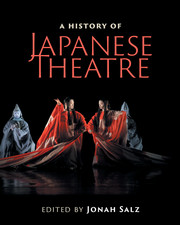Book contents
- Frontmatter
- Contents
- List of figures
- List of tables
- Contributors
- Contributors’ biographies
- Foreword
- Acknowledgments
- Note on Japanese terms
- List of abbreviations
- Timeline
- Editor's introduction
- I Traditional theatres
- Preface to Part I Japanese civilization arises
- 1 Ancient and early medieval performing arts
- Interlude Katari narrative traditions: from storytelling to theatre
- 2 Noh and Muromachi culture
- Interlude Noh and kyogen costumes and masks
- 3 Kyogen: classical comedy
- Interlude Iemoto : the family head system
- 4 Kabuki: superheroes and femmes fatales
- Interlude Nihonbuyo: classical dance
- Interlude Okinawan theatre: boundary of Japanese theatre
- 5 Bunraku: puppet theatre
- Interlude Misemono and rakugo : sideshows and storytelling
- Interlude Kamigata geinō : Kyoto-Osaka style
- Interlude Traditional theatre tomorrow: interview with Takemoto Mikio
- II Modern theatres
- Preface to Part II
- III Arcs and patterns
- IV Theatre architecture
- Preface to Part IV Evolution of Japanese theatre architecture
- V Theatre criticism
- VI Intercultural influences
- Epilogue: Frozen words and mythology
- Further reading
- Index
- References
Interlude Nihonbuyo: classical dance
from Preface to Part I Japanese civilization arises
Published online by Cambridge University Press: 05 July 2016
- Frontmatter
- Contents
- List of figures
- List of tables
- Contributors
- Contributors’ biographies
- Foreword
- Acknowledgments
- Note on Japanese terms
- List of abbreviations
- Timeline
- Editor's introduction
- I Traditional theatres
- Preface to Part I Japanese civilization arises
- 1 Ancient and early medieval performing arts
- Interlude Katari narrative traditions: from storytelling to theatre
- 2 Noh and Muromachi culture
- Interlude Noh and kyogen costumes and masks
- 3 Kyogen: classical comedy
- Interlude Iemoto : the family head system
- 4 Kabuki: superheroes and femmes fatales
- Interlude Nihonbuyo: classical dance
- Interlude Okinawan theatre: boundary of Japanese theatre
- 5 Bunraku: puppet theatre
- Interlude Misemono and rakugo : sideshows and storytelling
- Interlude Kamigata geinō : Kyoto-Osaka style
- Interlude Traditional theatre tomorrow: interview with Takemoto Mikio
- II Modern theatres
- Preface to Part II
- III Arcs and patterns
- IV Theatre architecture
- Preface to Part IV Evolution of Japanese theatre architecture
- V Theatre criticism
- VI Intercultural influences
- Epilogue: Frozen words and mythology
- Further reading
- Index
- References
Summary
The term buyō is a translation of the English “dance,” combining characters for two common terms, mai (舞) and odori (踊り). After theatre scholar and playwright Tsubouchi Shōyō (1859–1935) employed the term in his Shin gakugeki ron (New musical theatre theory, 1904), “buyō” was universally adopted, but in order to distinguish the classical Japanese repertoire from other dance forms, and as part of his larger project to develop a national drama (kokugeki), nihon (Japan) was appended. Nihonbuyo comprises both kabuki buyō and non-kabuki dances, mostly from the kamigata mai tradition of Osaka-Kyoto. Nihonbuyo performers are organized into schools, some headed by kabuki actors who adhere quite strictly to kabuki choreography, others by unaffiliated dancers who perform replications as well as adaptations of kabuki dance, in addition to new choreographies exclusive to nihonbuyo repertoires.
While nihonbuyo shares kabuki's dance repertoire, it has nonetheless developed a distinct identity. The majority of nihonbuyo instructors work outside the kabuki world; both male and female professionals teach amateurs of both genders. Since the Edo period (1603–1868), it has been an essential outlet for aspiring female performers, considered a “polishing school” for the arts of deportment and kimono-dressing, and, more recently, valued as a connection to Japanese heritage.
Historical overview
Nihonbuyo inherits movement styles from older dance forms derived from shrine, court, and folk dance. These may be analyzed as mai (circular), odori (leaping), and furi (mime).
The word mai comes from the verb mau (舞う), a contraction of mawaru (to rotate), signifying slow and deliberate circling movements. The body is held stiffly, the center of gravity low, knees bent slightly, while the soles of the feet are in continuous contact with the floor (suriashi). This strong relationship between dancer and floor is further emphasized by occasional stamping. The origins of mai can be traced back to the earliest forms of miko kagura in which shrine priestesses circle around to reach a state of trance, as well as bugaku, the stately court dance imported from China. Mai became the principal movement style in the noh theatre, appropriating popular kusemai in Kan'ami's time, then subsequently exerted a major influence on popular kabuki dance.
- Type
- Chapter
- Information
- A History of Japanese Theatre , pp. 141 - 149Publisher: Cambridge University PressPrint publication year: 2016

